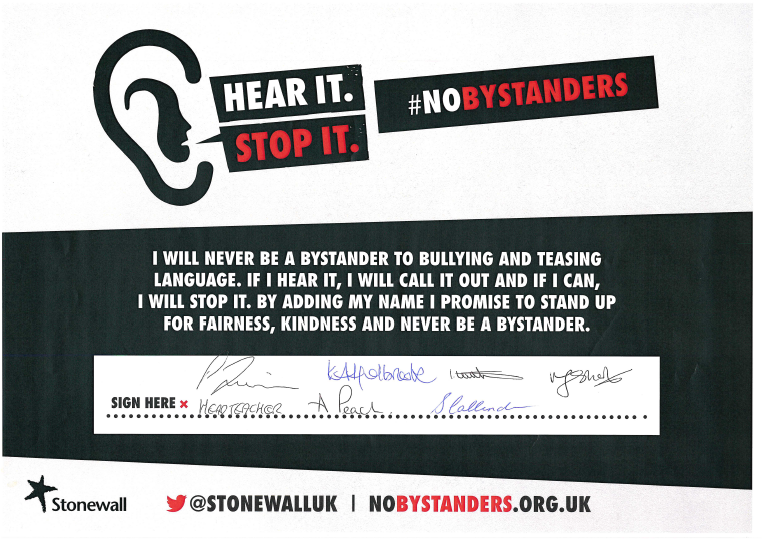LGBT School and Governors
Longbenton is an inclusive school. All members of the school community should feel free from discrimination of any sort (as laid down in the Equality Act 2010). To this end the school has an Anti-Bullying Policy that is known and understood by all, consistently applied, monitored and where appropriate, incidents recorded. Measures to protect pupils from bullying and discrimination as a result of gender, disability, gender reassignment, pregnancy and maternity, race (ethnic or national origins, colour or nationality), religion or belief, ability, sexual orientation (including LGBT) or background is clearly set out and regularly monitored for their effective implementation. All staff have had training in implementing this policy and have received the attached guidance.
Governors were keen to ensure that the new building reflected our inclusive aims. So for example, within the school there are non-gender assigned toilets as well as smaller changing areas for students who do not feel comfortable dressing for PE with their peers for any reason.
Gender Variance in Children and Young people
Gender variance, or Gender Identity Disorder, is the name given to people who don’t identify with the gender they were born with.
For the majority of children, the gender they are born into fits them, that is, the sex assigned at birth matches how they feel about themselves. A boy grows up feeling male, and becomes a man; a girl is comfortable in her femininity, and becomes a woman. For some children this isn’t the case, and their feelings inside don’t match their bodies or what is expected of them in terms of behaviour and dress. This is sometimes referred to as gender variance. Gender variant children express themselves in different ways, for example, their behavior and preferences may not seem usual for their gender, or they may express a wish to be the opposite gender. Some may insist that they have the wrong body.
Nobody can tell you for certain, at a young age, whether your child’s gender variance will continue beyond puberty and into adulthood. Some children exhibit gender issues as young as 2 or 3yrs old, while others may experience confusion but not express it until they are older. It isn’t unusual for some girls to prefer toys and clothes that are more associated with boys (‘tomboys’ are generally accepted), but there isn’t a commonly understood alternative for boys. Yet, some young boys do enjoy ‘female’ clothes and toys and this may be for a variety of reasons.
Suggested Approaches:
- Using preferred pronouns e.g. She/Her and their preferred name.
- Respecting the way the child is dressing to reflect the gender they identify with, for example: it is not a boy dressing as a girl but a girl dressing as she wishes too. By supporting the child to dress in the way they feel comfortable you are empowering them to be who they feel they truly are and expressing themselves.
- Listening and communication: trust that what the child/young person is presenting is their reality of that situation at that time.
- Confidentiality: information such as the child’s name, gender at birth or any detail of their transition constitutes as private information, and confidentially must be adhered to; this includes social media..
- The statistics for people in the LGBT community experiencing discrimination, poor mental health, and expressing suicidal intention are very concerning. By teaching our children equality and compassion for others, these statistics can be reduced and lives improved.
During Diversity week July 2017, students covered the below presentation in school assemblies:
For more information on this matter, visit the following websites:
GIRES online resource for parents and professionals
http://www.nlmscontent.nesc.nhs.uk/sabp/gv
This site is helpful: Understanding children's atypical gender behaviour - http://www.apa.org/monitor/sep03/children.aspx
Link to the Patchwork films with trans people giving their own personal stories
https://www.youtube.com/results?search_query=patchwork+transgender
